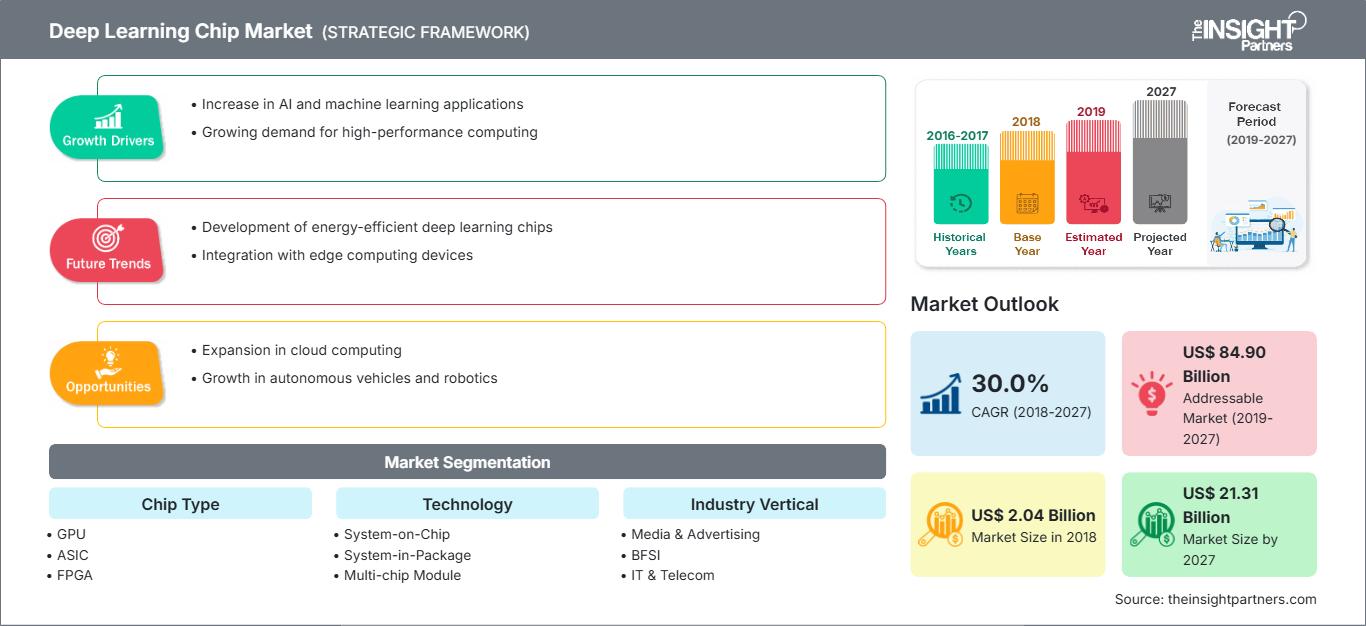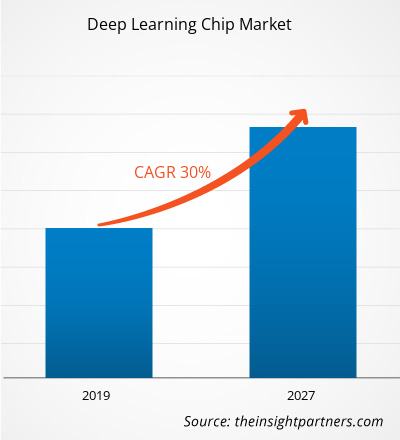Le marché mondial des puces d'apprentissage profond a représenté 2,04 milliards de dollars américains en 2018 et devrait croître à un TCAC de 30,0 % au cours de la période de prévision 2019-2027, pour atteindre 21,31 milliards de dollars américains d'ici 2027.
L'Amérique du Nord est en tête du marché mondial des puces d'apprentissage profond et devrait être le plus gros contributeur de revenus tout au long de la période de prévision. Le développement des puces d'apprentissage profond est soutenu par des investissements à grande échelle de la part de géants de la technologie pour développer des modèles à partir d'une énorme quantité de données générées. L'essor de l'informatique quantique et la mise en œuvre de puces d'apprentissage profond en robotique stimulent la croissance du marché des puces d'apprentissage profond dans les pays d'Amérique du Nord.
Informations sur le marché : L'importance de l'informatique quantique contribue à la croissance du marché des puces d'apprentissage profond.
L'informatique quantique prend quelques secondes pour terminer un calcul qui prendrait autrement plus de temps. Les ordinateurs quantiques sont une transformation innovante de l'intelligence artificielle, de l'apprentissage automatique et du big data. Par conséquent, l'importance de l'informatique quantique devrait stimuler la croissance du marché des puces d'apprentissage profond. De plus, l'informatique quantique est bénéfique pour divers facteurs, notamment l'optimisation des portefeuilles, la détection des fraudes et la gestion des risques, ainsi que pour les domaines nécessitant un retour d'information immédiat sur les données. Ainsi, un seul processeur peut effectuer plus facilement des calculs complexes en quelques secondes. De plus, grâce à l'ampleur et à la taille d'Internet, l'apprentissage profond permet de gérer de grands ensembles de données à très faible coût. Ces facteurs devraient donc stimuler la croissance du marché mondial des puces d'apprentissage profond.
Vous bénéficierez d’une personnalisation sur n’importe quel rapport - gratuitement - y compris des parties de ce rapport, ou une analyse au niveau du pays, un pack de données Excel, ainsi que de profiter d’offres exceptionnelles et de réductions pour les start-ups et les universités
Marché des puces d'apprentissage profond: Perspectives stratégiques

-
Obtenez les principales tendances clés du marché de ce rapport.Cet échantillon GRATUIT comprendra une analyse de données, allant des tendances du marché aux estimations et prévisions.
Le monde des affaires devient de plus en plus concurrentiel et, pour être compétitifs, les entreprises s'appuient aujourd'hui sur des informations utiles et des analyses commerciales. Traditionnellement, les outils d'analyse commerciale servaient à projeter les ventes à partir de données sur des événements datant d'une semaine ou d'un mois. Avec l'avènement de l'intelligence artificielle, qui apprend en temps réel et fournit des recommandations basées sur des modèles, les entreprises ont une formidable opportunité d'appliquer l'apprentissage profond à divers processus pour mieux comprendre l'environnement commercial et les clients.
Compte tenu de ces facteurs, l'intelligence artificielle permet aux entreprises d'améliorer leur efficacité opérationnelle, de réduire leurs coûts d'exploitation, d'améliorer la qualité de service et l'expérience client.
Informations sur les types de puces
Les processeurs graphiques (GPU) détenaient la principale part de marché des puces d'apprentissage profond en 2018, tandis que les circuits intégrés spécifiques aux applications (ASIC) devraient être le segment qui connaîtra la croissance la plus rapide au cours de la période de prévision. Bien que les ASIC soient très spécifiques et moins flexibles, ils constituent l'une des options matérielles les plus performantes pour les applications d'intelligence artificielle.
Informations technologiques
Les chipsets d'apprentissage profond comprennent les systèmes sur puce, les systèmes en boîtier, les modules multipuces, etc. En 2018, le segment des systèmes sur puce détenait la plus grande part de marché des puces d'apprentissage profond, car il contribue à réduire le gaspillage d'énergie, l'espace occupé par les grands systèmes et les coûts.
Informations sur les secteurs d'activité
Le marché mondial des puces d'apprentissage profond est divisé en secteurs : BFSI, commerce de détail, informatique et télécommunications, automobile et transport, santé, médias et divertissement, etc. Le BFSI détenait la majeure partie du marché des puces d'apprentissage profond, tandis que le secteur de la santé devrait connaître la croissance la plus rapide. Français Les facteurs tels que la réduction des coûts opérationnels, l'adaptation à l'évolution des conformités et des réglementations, la concentration sur le cœur de métier et l'intégration de l'automatisation dans les processus métier sont d'autres facteurs majeurs qui alimentent la croissance du segment BFSI sur le marché des puces d'apprentissage profond.
Les acteurs du marché présents sur le marché des puces d'apprentissage profond se concentrent principalement sur l'amélioration des produits en mettant en œuvre des technologies avancées. La signature de partenariats, de contrats, de coentreprises, de financements et l'inauguration de nouveaux bureaux à travers le monde permettent à l'entreprise de maintenir sa marque à l'échelle mondiale. Quelques-uns des développements récents sont énumérés ci-dessous :
2019 : NVIDIA s'est associé à Hackster.io pour lancer l'AI at the Edge Challenge, une compétition où les développeurs utilisent le kit de développement NVIDIA Jetson Nano pour créer des projets créatifs et uniques et ont une chance de gagner jusqu'à 100 000 $ de prix.
2019 : Intel a annoncé son projet d'agrandir son usine de l'Oregon pour produire une puce de 7 nm. La nouvelle usine d'Intel constituera la troisième phase de D1X, une usine gigantesque lancée par Intel en 2010. Chacune des deux premières phases représentait 1,1 million de pieds carrés, créant ainsi une installation combinée équivalente à 15 magasins-entrepôts Costco. La troisième phase augmenterait apparemment la surface de production de D1X d'environ 50 %. De plus, Intel affirme que l'agrandissement de son usine lui permettra de répondre 60 % plus rapidement aux pénuries de puces.
2019 : Huawei a lancé le HiSecEngine USG12000, le premier AIFW de niveau T du secteur. Le HiSecEngine USG12000 est équipé de puces Ascend AI, qui offrent des capacités de détection intelligente ainsi qu'une défense intelligente des frontières pour les réseaux d'entreprise.
Aperçu régional du marché des puces d'apprentissage profond
Les tendances régionales et les facteurs influençant le marché des puces d'apprentissage profond tout au long de la période de prévision ont été analysés en détail par les analystes de The Insight Partners. Cette section aborde également les segments et la géographie du marché des puces d'apprentissage profond en Amérique du Nord, en Europe, en Asie-Pacifique, au Moyen-Orient et en Afrique, ainsi qu'en Amérique du Sud et en Amérique centrale.
Portée du rapport sur le marché des puces d'apprentissage profond
| Attribut de rapport | Détails |
|---|---|
| Taille du marché en 2018 | US$ 2.04 Billion |
| Taille du marché par 2027 | US$ 21.31 Billion |
| TCAC mondial (2018 - 2027) | 30.0% |
| Données historiques | 2016-2017 |
| Période de prévision | 2019-2027 |
| Segments couverts |
By Type de puce
|
| Régions et pays couverts |
Amérique du Nord
|
| Leaders du marché et profils d'entreprises clés |
|
Densité des acteurs du marché des puces d'apprentissage profond : comprendre son impact sur la dynamique des entreprises
Le marché des puces d'apprentissage profond connaît une croissance rapide, portée par une demande croissante des utilisateurs finaux, due à des facteurs tels que l'évolution des préférences des consommateurs, les avancées technologiques et une meilleure connaissance des avantages du produit. Face à cette demande croissante, les entreprises élargissent leur offre, innovent pour répondre aux besoins des consommateurs et capitalisent sur les nouvelles tendances, ce qui alimente la croissance du marché.

- Obtenez le Marché des puces d'apprentissage profond Aperçu des principaux acteurs clés
- Analyse historique (2 ans), année de base, prévision (7 ans) avec TCAC
- Analyse PEST et SWOT
- Taille du marché Valeur / Volume - Mondial, Régional, Pays
- Industrie et paysage concurrentiel
- Ensemble de données Excel
Rapports récents
Témoignages
Raison d'acheter
- Prise de décision éclairée
- Compréhension de la dynamique du marché
- Analyse concurrentielle
- Connaissances clients
- Prévisions de marché
- Atténuation des risques
- Planification stratégique
- Justification des investissements
- Identification des marchés émergents
- Amélioration des stratégies marketing
- Amélioration de l'efficacité opérationnelle
- Alignement sur les tendances réglementaires






















 Obtenez un échantillon gratuit pour - Marché des puces d'apprentissage profond
Obtenez un échantillon gratuit pour - Marché des puces d'apprentissage profond